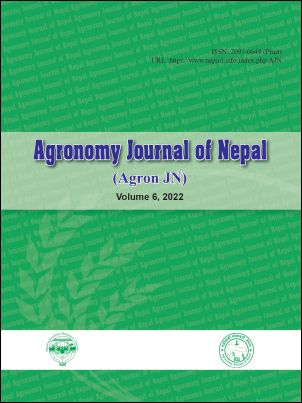The Systems Productivity, Profitability and Soil Properties are Altered by Tillage Methods and Cropping Systems in the Mid-hills of Nepal
DOI:
https://doi.org/10.3126/ajn.v6i1.47955Keywords:
Conservation tillage, cropping pattern, economics, soil properties, system yieldsAbstract
With the aim of identifying appropriate crop establishment methods in cereals-cereals, cereals-legumes, legumes-cereals and legumes-legumes cropping patterns, an experiment was carried out during 2019/20 to 2020/21 in National Agronomy Research Centre, Khumaltar. The experiment was laid out in split plot design with 8 treatments and 3 replications. Main plot was for two tillage methods [Zero tillage (ZT) and conventional tillage (CT)] and sub-plots for 4 different cropping patterns (maize-wheat, maize-lentil, soybean-wheat and soybean-lentil). In zero tillage, the soil was disturbed only along the rows for making seeding furrows and the previous crop residues were left anchored. The rest of the crop management practices were adopted as per the recommended practices. The data were analyzed using GenStat software. The results revealed that tillage treatments did not influence the winter crop yields in 2019, but in 2020, ZT recorded a significantly higher yield of wheat (4.9 Mt ha-1) compared to CT (3.4 Mt ha-1). Similarly, irrespective of crop establishment methods, pooled system yields and benefit: cost ratios were significantly influenced by various cropping patterns. The significantly higher system yield was recorded with maize-wheat (9.0 Mt ha-1) and the least with the soybean-lentil (5.2 Mt ha-1) cropping systems. Improvements in the soil properties were observed as SOM was 14% higher in ZT compared to CT. Similarly, average soil moisture and soil temperature in ZT and CT were found to be 30.2%, 27.5 °C and 28.7%, 29.4 °C, respectively. It is suggested that CA could possibly be an alternative production system for the fragile agro-ecology in the mid-hills of Nepal.
Downloads
Downloads
Published
How to Cite
Issue
Section
License
Copyright (c) 2022 Agronomy Society of Nepal (ASoN)

This work is licensed under a Creative Commons Attribution-NonCommercial 4.0 International License.
ASON permits for free use, distribution and reproduction in any medium if the original work is properly cited and not used for commercial purposes.




